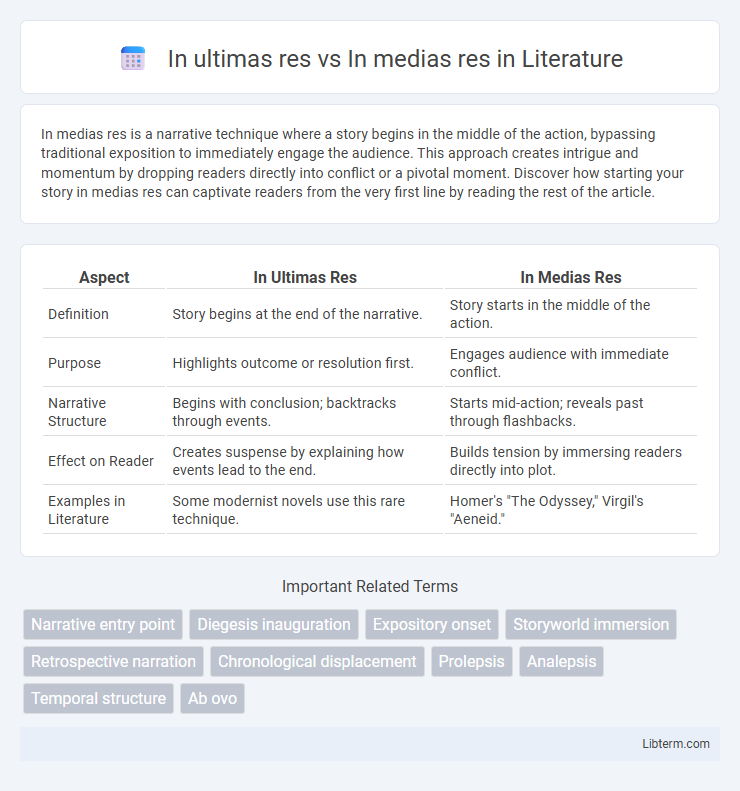In medias res is a narrative technique where a story begins in the middle of the action, bypassing traditional exposition to immediately engage the audience. This approach creates intrigue and momentum by dropping readers directly into conflict or a pivotal moment. Discover how starting your story in medias res can captivate readers from the very first line by reading the rest of the article.
Table of Comparison
| Aspect | In Ultimas Res | In Medias Res |
|---|---|---|
| Definition | Story begins at the end of the narrative. | Story starts in the middle of the action. |
| Purpose | Highlights outcome or resolution first. | Engages audience with immediate conflict. |
| Narrative Structure | Begins with conclusion; backtracks through events. | Starts mid-action; reveals past through flashbacks. |
| Effect on Reader | Creates suspense by explaining how events lead to the end. | Builds tension by immersing readers directly into plot. |
| Examples in Literature | Some modernist novels use this rare technique. | Homer's "The Odyssey," Virgil's "Aeneid." |
Introduction to Narrative Techniques
In narrative techniques, "In medias res" refers to beginning a story in the midst of action, immediately engaging the audience by dropping them directly into the plot, often followed by flashbacks to provide context. Conversely, "In ultimas res" starts a narrative near its conclusion, revealing events leading up to the climax, creating suspense through retrospection. Both techniques strategically manipulate temporal structure to enhance storytelling impact and audience engagement.
Defining "In Ultimas Res
In ultimas res is a Latin phrase meaning "into the final things" and refers to a narrative technique that begins at the end or conclusion of a story. This contrasts with in medias res, which starts in the middle of events, often at a pivotal or exciting point. In ultimas res emphasizes resolving the plot by exploring outcomes before explaining preceding causes or actions.
Defining "In Medias Res
In medias res is a narrative technique where a story begins in the middle of the action, bypassing initial exposition to create immediate engagement. This approach contrasts with in ultimas res, which starts at the story's end or conclusion. By employing in medias res, writers immerse readers directly into critical events, enhancing suspense and compelling them to piece together background details through flashbacks or dialogue.
Historical Origins and Literary Roots
In ultimas res and in medias res trace back to classical rhetoric and ancient literature, specifically the works of Aristotle and Roman orators who shaped narrative techniques by controlling story entry points. In medias res, rooted in Homer's epics, starts stories amid action, enhancing engagement by immersing audiences immediately. In contrast, in ultimas res places the beginning of a narrative near its conclusion, a less frequent but equally strategic choice seen in certain Roman and Renaissance texts to emphasize outcomes over processes.
Structural Differences: In Ultimas Res vs. In Medias Res
In ultimas res begins the narrative at the story's conclusion, revealing key outcomes before tracing events backward, emphasizing resolution and reflection. In medias res starts the story amid pivotal action without preliminary exposition, engaging the audience through immediate conflict and suspense. Structural differences lie in timeline presentation: in medias res utilizes a middle entry point to build tension, whereas in ultimas res employs reverse chronology to highlight consequences and character transformations.
Impact on Plot Development
In medias res accelerates plot development by thrusting the audience directly into the action, creating immediate tension and curiosity that drive the narrative forward. In ultimas res, by contrast, starts near the story's conclusion, prompting reflection and reinterpretation of prior events, which can deepen emotional resonance and thematic complexity. Each technique influences pacing and engagement differently, with in medias res emphasizing momentum and in ultimas res fostering retrospective insight.
Effects on Characterization and Reader Engagement
In ultimas res places the narrative near the story's end, intensifying character arcs by spotlighting transformation and resolution, which deepens readers' understanding of growth and consequence. In medias res begins amid action, immediately engaging readers through dynamic scenes and suspense, prompting curiosity about characters' pasts and motivations. This technique enhances characterization through gradual revelation and fosters sustained reader investment by unfolding the story progressively.
Notable Examples in Literature and Film
In ultimas res, a narrative begins near the story's conclusion, exemplified by Homer's "Odyssey," where the tale unfolds after Odysseus returns home. In medias res starts amid the action, famously employed in Virgil's "Aeneid" and films like "Pulp Fiction," where the plot begins without exposition. Both techniques create immediate engagement, with ultimas res focusing on resolution and in medias res emphasizing dynamic storytelling.
Choosing the Right Technique for Your Story
In ultimas res places the narrative at the story's conclusion, creating suspense by gradually revealing prior events through flashbacks or dialogue, ideal for mysteries or twist endings. In medias res begins the story in the middle of action, immediately engaging readers and providing dynamic momentum, often favored in adventure or thriller genres. Selecting the right technique depends on your story's pacing and thematic needs--use in medias res for urgency and immediacy, and in ultimas res to build intrigue and retrospective understanding.
Conclusion: Weighing Storytelling Approaches
In ultimas res begins storytelling at the story's conclusion, offering immediate resolution and emphasizing the outcome's significance, which can create a powerful emotional impact. In medias res starts in the middle of action, engaging the audience with suspense and requiring backstory integration to clarify motivations and events. Choosing between these approaches depends on whether the narrative prioritizes dramatic closure or dynamic unfolding for audience immersion.
In ultimas res Infographic

 libterm.com
libterm.com